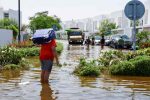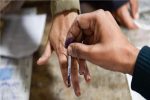
India may face deadly heat waves within decades: study
Team Udayavani, Aug 3, 2017, 2:59 PM IST

Boston (USA): Nearly 1.5 billion people in India, Pakistan and Bangladesh are likely to face deadly heat waves within the next few decades due to climate change, exposing them to unsurvivable temperatures and widespread food crisis, an MIT study has warned.
Scientists predicted that by the end of this century climate change could lead to severe summer heat waves in South Asia, a region of deep poverty where one-fifth of the world’s population resides.
There is still time to avert such severe warming if measures are implemented now to reduce the most dire consequences of global warming, researchers said.
However, without significant reductions in carbon emissions, the heat waves could begin within as little as a few decades to strike the fertile Indus and Ganges river basins that produce much of the region’s food supply, they said.
The areas likely to be hardest hit in northern India, Bangladesh and southern Pakistan are home to 1.5 billion people.
These areas are also among the poorest in the region, with much of the population dependent on subsistence farming that requires long hours of hard labour out in the open and unprotected from the Sun.
“That makes them very vulnerable to these climatic changes,” said Elfatih Eltahir, from MIT.
While the projections show the Persian Gulf may become the region of the worst heat waves on the planet, northern India is a close second, Eltahir said, and eastern China, also densely populated, is third.
The highest concentrations of heat in the Persian Gulf would be out over the waters of the Gulf itself, with lesser levels over inhabited land.
The new analysis is based on recent research showing that hot weather’s most deadly effects for humans comes from a combination of high temperature and high humidity, an index which is measured by a reading known as wet-bulb temperature.
This reflects the ability of moisture to evaporate, which is the mechanism required for the human body to maintain its internal temperature through the evaporation of sweat.
At a wet-bulb temperature of 35 degrees Celsius, the human body cannot cool itself enough to survive more than a few hours.
A previous study of temperature and humidity records show that in today’s climate, wet-bulb temperatures have rarely exceeded about 31 degrees Celsius anywhere on Earth.
While an earlier report from researchers showed that this survivability limit would start to be exceeded occasionally in the Persian Gulf region by the end of this century, actual readings there in the summer of 2015 showed that the 35-degree wet-bulb limit had almost been reached already, suggesting that such extremes could begin happening earlier than projected.
The summer of 2015 also produced one of the deadliest heat waves in history in South Asia, killing an estimated 3,500 people in Pakistan and India. Yet, India and China remain two countries where emission rates of greenhouse gases continue to rise, driven mostly by economic growth, Eltahir said.
The study shows that by century’s end the most extreme, once-in-25-years heat waves would increase from wet-bulb temperatures of about 31 to 34.2 degrees Celsius. “It brings us close to the threshold of survivability,” he said.
In today’s climate, about two per cent of the Indian population sometimes gets exposed to extremes of 32-degree wet-bulb temperatures.
According to this study, by 2100 that will increase to about 70 per cent of the population, and about two per cent of the people will sometimes be exposed to the survivability limit of 35 degrees.
The region is important agriculturally, it is not just those directly affected by the heat who will suffer, Eltahir said.
“With the disruption to the agricultural production, it doesn’t need to be the heat wave itself that kills people. Production will go down, so potentially everyone will suffer,” he said.
Udayavani is now on Telegram. Click here to join our channel and stay updated with the latest news.
Top News
Related Articles More

China says talks on Tibet only with Dalai Lama’s representatives; rules out dialogue on autonomy

Indian-origin man shot, killed by San Antonio police amid attempts to apprehend him

2 Indian restaurants in Colorado duped investors of USD 380K: Officials

WATCH: 5 runaway military horses cause mayhem in London

Don’t blame Dubai’s freak rain on cloud seeding
MUST WATCH
Latest Additions

Patanjali Foods to evaluate proposal to buy Patanjali Ayurved’s non-food business

Congress to discuss candidates for Amethi, Raebareli seats on Saturday

BJP’s CT Ravi Booked for Promoting Hatred and Enmity Through Social Media Post

Elections held in 14 LS segments in Karnataka, voter turnout nearly 64 per cent till 5 pm

‘PM is scared, may even shed tears on stage’: Rahul Gandhi’s fresh salvo at Modi

























